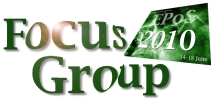
 |


 |
|
The Formation of Rich Clusters
Convenor: Eric Feigelson Thursday, 17 June 2010, 17:10-18:30 |
| Most stars form in or around rich OB-dominated star clusters, yet we still have very incomplete understanding of the astrophysical processes involved in cluster formation. This Focus Group provides a discussion forum on topics including: cloud conditions leading to rich cluster formation; fast vs. slow cluster formation; mechanisms of high mass star formation; mechanisms and prevalence of mass segregation; temporal sequences (OB vs. low mass stars; central cluster vs. triggered stars); and feedback from OB radiation/winds. |
|
Large-Scale Structure in Molecular Clouds
Convenors: Jens Kauffmann, Alyssa Goodman, Mario Tafalla Wednesday, 16 June 2010, 17:20-18:30 |
|
Today, instruments like SCUBA II and Herschel provide us for the first time with sensitive maps of entire molecular clouds. To fully exploit the data, we must adopt a new paradigm for studies of molecular clouds; it appears inefficient to break clouds up into "cores" and "clumps". But what do we do instead? We have already considered "extinction thresholds" for star formation, examined how cores move with respect to their envelope, and tested whether clouds are "fractal". Are there other approaches to relate cloud structure on small and large spatial scales? This leads to another important question: which parameters (and how many) are needed to comprehensively characterize a cloud (in observations and simulations)? This will be an informal brainstorming session. We start off with a short introduction (~20 min; figure and slide contributions welcome). To stimulate discussion, brief interjections (~5 min) on observations and theory will be provided by Andre, Banerjee, and Hennebelle. |
|
Magnetic Field Observations: Testing Star Formation Theory
Convenor: Richard Crutcher Thursday, 17 June 2010, 11:50-12:40 |
|
In spite of decades of work on the roles of magnetic fields and turbulence in driving star formation, the question of their relative importance remains open. This focus group will be a discussion between observers and theorists. Theorists and observers should come to the focus group having thought about the following. Theorists should think about new observations that could provide definitive tests of their theories, and about how the results of their simulations could be presented in a way that could be compared directly with what can be observed. Observers should think about the capabilities of the next generation of new telescopes and instruments for obtaining improved and novel new measurements of continuum and spectral line polarization that can be compared directly with theoretical results in order to test star formation theory. After a very brief opening presentation by the convenor, the format will be discussion and not formal presentations. The goal of this focus group is not just to extend the formal magnetic fields session with additional presentations of new results, but to have a discussion between observers and theorists about what would be the most useful observations that would test theoretical results and what theorists and simulators should provide in terms of predicted observational results. |
|
Computational Challenges: Where do we go from here?
Convenor: Richard Klein Thursday, 17 June 2010, 17:10-18:30 |
|
The advent of new computational platforms with computing at the Petascale
and beyond are upon us. What position is our field in to take advantage of this new dawn in computational performance and capability? What are the problems that will demand it? What are the current roadblocks in our numerical simulations? Brief presentations (~ 5 minutes) will be made discussing the computational advances needed in current star formation simulation capability from the point of view of new algorithms, physics and computer science. Currently, contributions are planned from Klein, Banerjee, Steinacker, Baraffe, Clark, Nordlund, possibly also from Mac-Low, Heitsch, Hennbelle, Padoan, Kuiper, and Tomida. Burkert, Chabrie, Pudritz, and Nakamura have indicated that they might participate. The brief presentations will be followed by open discussion. |
|
The Herschel satellite: the new observing tool for EPoS aficionados/aficionadas
Convenors: Markus Nielbock, Hendrik Linz Wednesday, 16 June 2010, 17:20-18:30 |
|
The Herschel telescope with its mapping and spectroscopy capabilities in the
FIR/sub-millimeter is an ideal tool to investigate especially the very early,
highly embedded phases of star formation. At the time of the EPoS 2010
conference, the mission will be already in its second year, with a proposal
deadline for open time proposals just ahead (July 22, 2010).
In this focus group discussion, we will summarise the imaging abilities of the
instruments PACS (and SPIRE), also from the viewpoint of our tasks within the
PACS instrument team regarding performance verification and calibration. In
particular observing and data reduction strategies should be critically
discussed. This shall contribute to our understanding of the strengths and
caveats of the Herschel data products, and to what extent this affects the
interpretation of Herschel data, especially for star-forming regions.
We will start with four short talks (Nielbock, Linz, Hennemann, Molinari), which should give the basis for lively discussion. |
|
The EPoS way: Large group, small room, remote location. Consider all aspects.
Short talks, intense discussions. |